The best recipes for preparing dill for the winter
Dill - a popular seasoning with a recognizable taste and aroma. It is added to sauces, soups, hot and cold dishes, and is used fresh, dried and canned. In addition, the leaves of the plant have a wide range of beneficial properties.
Preparing greens for the winter will not be difficult, even for those who have never encountered home canning before.
The content of the article
Chemical composition, vitamins and beneficial properties of dill
Dill contains a large amount of beta-carotene and vitamins A, C, K. Fresh greens contain magnesium, cobalt and chromium salts, which are necessary for the normal functioning of the body.
The calorie content of the product is 40 kcal per 100 g, which consist of: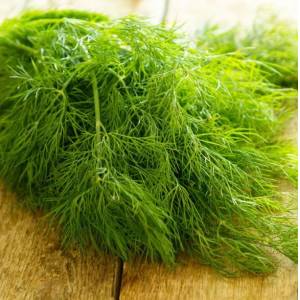
- carbohydrates - 6.3 g;
- proteins - 2.5 g;
- fats - 0.5 g;
- dietary fiber - 2.8 g;
- water - 86 g.
Fresh seasoning allows normalize the work of the gastrointestinal tract, especially when eating heavy food. This is due to the enzymes included in the greenery, which accelerate the process of fiber breakdown.
Preparing the necessary ingredients
For the preparation of seasoning for the winter, it is mainly used its green part - leaves and sometimes thin stems. Umbrellas are used for canning vegetables and are rarely used for storageexcept for seeds.
Healthy, intact leaves are washed and dried so that they do not wilt or rot. Processing is carried out according to the selected recipe.
Preservation methods for the winter
To preserve greens in various forms, there are many methods and recipes, the essence of which boils down to drying, freezing, canning.
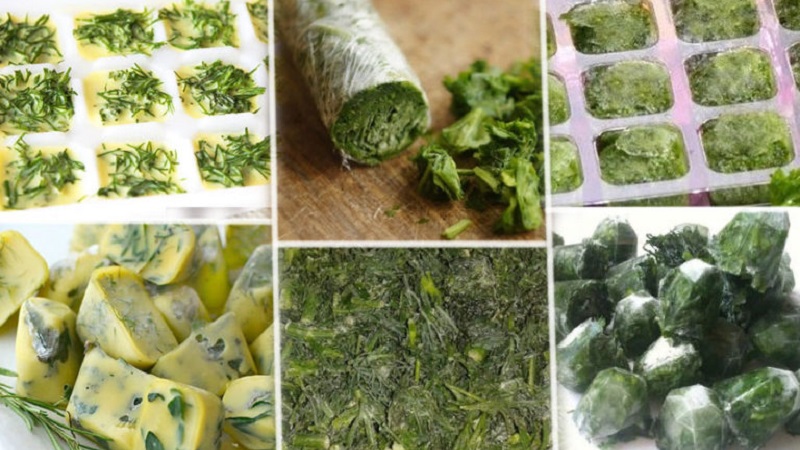
The most simple
Drying and freezing are some of the easiest ways to preserve dill. They do not require special financial and physical costs. Dill can be dried both in the fresh air and in a special dehydrator. This allows the seasoning to keep its flavoring properties as long as possible.
In a bag in the refrigerator
Storing dill in the refrigerator is often short-lived - in the best case scenario, it will not last more than two weeks. However, if you need to wait a few days before another treatment and keep the greens fresh, this method will work.
The washed and dried bundles are packed tightly in a plastic bag, which is sealed with tape and placed in the refrigerator.

In a container with water
Fresh herbs can be stored in a jar or container of water. A prerequisite for such storage is a tightly closed container lid. Freshly harvested dill is collected in bunches and put into a container, a quarter filled with water. The container is tightly closed and placed in the refrigerator.
You can also store dill like flowers by simply placing the bunch in a container of water.
In a paper towel
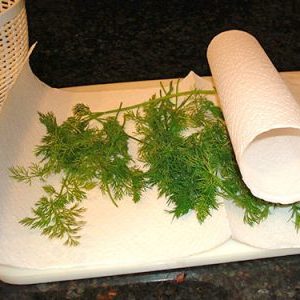 This method allows you to keep fresh dill for up to three weeks.
This method allows you to keep fresh dill for up to three weeks.
Dill bunches are wrapped in a paper napkin or towel.
The package is slightly moistened with water, placed in a plastic bag and placed in the cold.
For greater safety of dill, change the paper at least once every 3-4 days.
In a bank or package
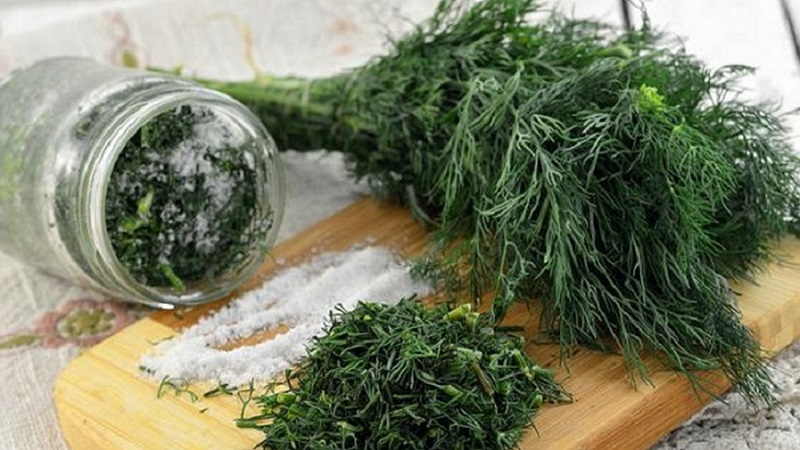
Storage in a hermetically sealed jar or bag will keep dill fresh for up to three months. The washed dried greens are separated from the stalks and placed tightly in a prepared container. The filled jar or bag is placed in a dark, cold place.
Important. The can should be tightly closed and not let in air, the bag should be tightly closed.
In a sterilized jar
Sterilizing the container slows down the deterioration process. The prepared jar is sterilized by calcining or steaming. The washed and dried greens are tightly placed in a sterile container. Banks are kept in the refrigerator.
In foil
Clean and dried bunches of dill are folded into foil prepared according to the size of the bunches. The foil is wrapped in an envelope and folded into a plastic bag. These envelopes are stored either in the refrigerator or in the freezer. The dill stays fresh for up to two months.
Freezing in ice cube trays
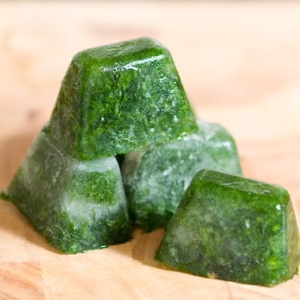
Freezing cannot be called the best way, because due to the effect of low temperatures, enzymes and vitamins are destroyed, the taste and aromatic properties of greens are reduced. However, freezing in ice cube trays is popular for storing dill.
The greens are cut into small pieces and placed in ice molds, poured with boiled water at room temperature and sent to the freezer. Such dill can be used in various soups, adding the whole cube at once.
You can freeze bundles of greens, previously washed and dried, wrapped in plastic or foil. For soup or salad, such a “sausage” is simply taken out and cut while still frozen.
Drying
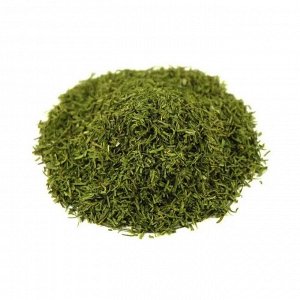
Drying dill is perhaps the most popular way to prepare seasoning. Dried dill is used in many hot dishes.
Washed and dried dill is finely chopped and laid out in a thin layer on paper or in dehydrator containers. This drying takes 2-3 days. Drying in the oven is allowed - both with whole leaves and finely chopped.
Dill can also be dried in bunches. The collected bundles are hung with the leaves down in a well-ventilated place, protected from direct sunlight. The greens harvested in this way retain their color.
Canning
Fresh young shoots are used for canning. Salting is most often used - dry or with marinade. The leaves are crushed and placed tightly in layers with salt or filled with prepared marinade.
Marinated
There are many recipes for pickling dill. The simplest marinade includes vinegar, water, and salt. More complex recipes can include bay leaves, sweet peas, and other spices and seasonings.
Reference. Dill can be marinated either alone or in combination with parsley, green onions, cilantro and other herbs.
Others
There are many other ways to preserve greens for the winter - ground with oil and salt as a smoothie, in vacuum containers, frozen bunches, and also in some sauces.
Recipes
To preserve dill, you can resort not only to harvesting in its pure form, but also to salting, pickling, making seasonings and sauces based on it.
Salting in layers in a jar
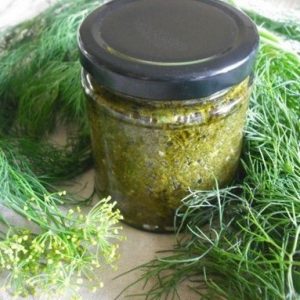
Ingredients:
- fresh dill;
- coarse sea salt.
The washed, dried dill is separated from the branches and tamped tightly into sterile jars in layers, sprinkling them with coarse sea salt. Layers of dill should not exceed 2 cm. The optimal ratio is 2 parts of dill, 1 part of salt.
Salting with marinade
Ingredients:
- fresh dill - 800 g;
- water - 500 ml;
- coarse salt - 5 tsp;
- sugar - 10 g;
- allspice peas - 6 peas;
- bay leaf - 2 pcs;
- table vinegar 6% - 250 ml.
Banks are sterilized in a water bath for 20 minutes. The water is boiled in an enamel pan, salt and sugar are added until completely dissolved. Then add pepper, bay leaf and vinegar and boil for 5-6 minutes. The greens are finely chopped and tamped into sterile containers, poured with boiling marinade and covered with tight lids.Sterile jars are rolled up, allowed to cool and stored in a cool dark place.
Canned dry salting
Ingredients: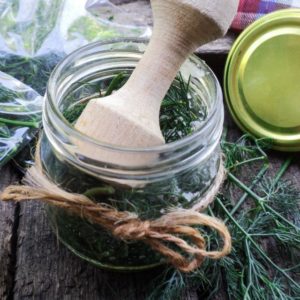
- dill;
- salt.
Fresh dill is chopped and dried in the air or in the oven. Dried herbs are mixed with salt in a ratio of 4: 1. The mixture is tamped into sterile containers with tight-fitting lids and placed in a dark, cool place.
Pickled dill
Ingredients:
- fresh dill - 500 g;
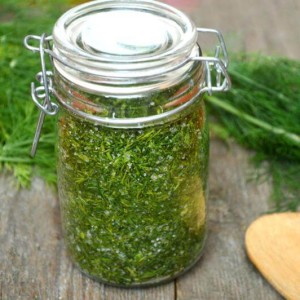
- water - 300 ml;
- apple cider vinegar 9% - 200 ml;
- coarse salt - 100 g.
The water is mixed with salt and vinegar and brought to a boil. The greens are finely chopped and tamped into sterile containers, filled with boiling marinade. The containers are tightly closed or rolled up and placed under a warm blanket for 10-12 hours. The cooled jars are stored in a cool dark place.
Oil seasoning
Ingredients:
- fresh dill - 2 large bunches;
- fresh garlic - 10 cloves;
- vegetable oil - 100 ml;
- citric acid - 0.5 tsp;
- salt.
Greens and dill are chopped in a blender or finely chopped, mixed with oil, salt and citric acid. The mixture is heated for 10-15 minutes and poured into containers.
Infusion with oil
Ingredients:
- fresh dill;
- refined olive or sunflower oil.
The greens are crushed in a blender and tamped tightly into a sterile container, poured over with heated vegetable oil. A closed jar is insisted for two weeks in a dark, cool place.
Pesto
Ingredients: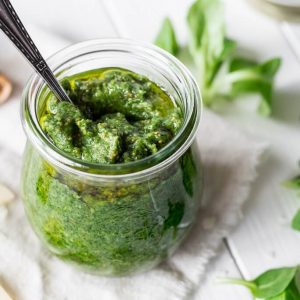
- fresh dill - 200 g;
- garlic - 3 cloves;
- salt - 0.5 tsp;
- pine nuts, walnuts or almonds - 50 g;
- ground black pepper - 0.5 tsp;
- grated lemon zest - 1 tsp;
- olive oil - 50 ml.
All ingredients are ground in a blender. The mixture is laid out in sterile containers and rolled up.
Useful Tips
Tips from experienced housewives will help extend the shelf life and value of the blanks:
- When storing dill in bunches in water, greens are washed only before use.
- Before harvesting greens, it is important to sort it out from dry and rotten leaves.
- Sterilization of containers for storing greens will increase the shelf life.
- Dried dill is stored in closed bags or jars in a dry, dark place.
- Salting the seasoning keeps her beneficial features.
Conclusion
With a competent approach to harvesting, you can pamper yourself with summer vitamins throughout the winter, which is especially important in regions with short summers. The main thing is to choose the optimal way of harvesting for yourself and follow the storage rules.